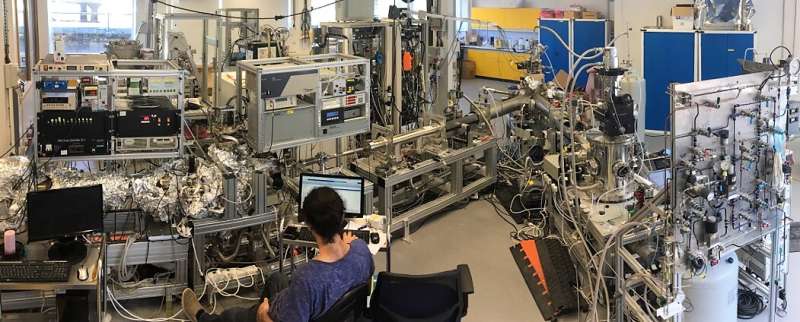Helicopter or cartwheel? What happens when a molecule collides with a surface

What happens when a molecule collides with a surface? Researchers at Swansea University have shown that the orientation of the molecule as it moves—whether it is spinning like a helicopter blade or rolling like a cartwheel—is important in determining what happens in the collision.
The interaction of molecules with surfaces lies at the heart of many research fields and applications: plant fertilizers and chemicals, industrial catalysts, atmospheric chemical reactions on ice and dust particles, and even—in space—the processes through which a star is born.
A key question in the field of surface science is understanding whether a molecule, when it collides with a surface, will scatter back to the gas phase, adsorb on the surface, or react and break down into fragments.
One molecular property which can change the outcome of a collision is the rotational orientation of the molecule. However, the current understanding of this relation is very limited, as it is usually impossible to control or measure the orientation of a rotating molecule.
This is where the Swansea team's research comes in. The team, led by Professor Gil Alexandrowicz of Swansea University chemistry department, has developed a new type of experiment which enabled them to assess two things:
- how the rotational orientation of the molecule, just before the collision, changes the scattering probabilities; and then
- how the collision in turn changes the orientation of the molecules ejected back into the gas phase.
The experiments performed by Yosef Alkoby, a Ph.D. student in the group, used magnetic fields to control the rotational quantum states of hydrogen molecules before and after colliding with the surface of a salt crystal.
A quantum mechanical simulation, developed by Dr. Helen Chadwick, was used to extract the scattering matrix from the measurement. This is a detailed descriptor which reveals exactly how rotation orientation affects the collision and how the collision changes the way the molecules rotate.
Until now, scattering matrices could only be estimated from theoretical calculations. In their new paper, the Swansea team have demonstrated for the first time an experimental determination of a scattering matrix, opening up new opportunities for studying and modeling molecule-surface interactions.
Key findings were:
- The molecule-surface interaction potential of hydrogen with Lithium Fluoride depends strongly on the rotational orientation of the hydrogen molecules.
- The scattering matrix obtained from the experiments confirms that collisions of hydrogen with Lithium Fluoride can change the rotational orientation of the molecule and provides the information needed to use this simple salt surface to rotationally orient hydrogen molecules.
- The scattering matrix obtained from the experiment provides an extremely stringent benchmark which will guide the development of accurate theoretical models.
Professor Gil Alexandrowicz of Swansea University College of Science, lead researcher, said:
"Our research reports a new type of molecule-surface collision experiment. We examined the orientation of a rotating ground-state molecule approaching a surface and how this changes the collision event.
Being able to model the outcome of a molecule-surface collision yields valuable insights for many fields of study. Yet even modeling the simplest molecule, H2, with a metal surface accurately still presents a significant challenge.
To develop accurate models, it is crucial to have results from fundamental surface-science experiments to benchmark theoretical descriptions against.
Our results provide a new and particularly sensitive bench mark for theory development, as the ability to calculate the collision and successfully reproduce the experimentally determined scattering matrix, requires a particularly accurate model for the molecule-surface interaction. "
More information: Yosef Alkoby et al, Setting benchmarks for modelling gas–surface interactions using coherent control of rotational orientation states, Nature Communications (2020). DOI: 10.1038/s41467-020-16930-1
Journal information: Nature Communications
Provided by Swansea University





















